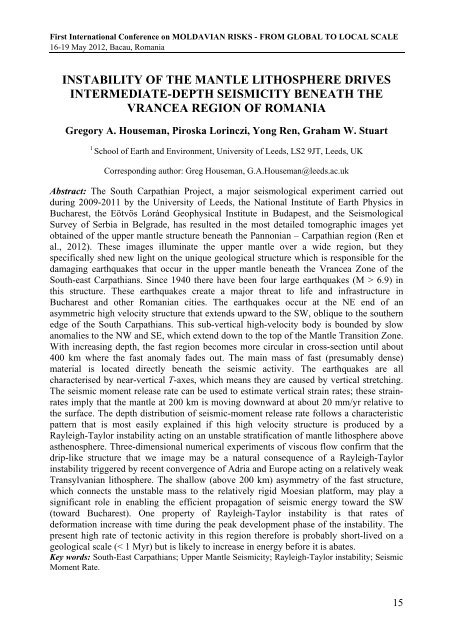First International Conference on MOLDAVIAN RISKS – FROM ...
First International Conference on MOLDAVIAN RISKS – FROM ... First International Conference on MOLDAVIAN RISKS – FROM ...
- Page 1: “VASILE ALECSANDRI” UNIVERSITY
- Page 4 and 5: Editors: Mioara Mandea, Gabriel Laz
- Page 7 and 8: First Inte
- Page 9 and 10: First Inte
- Page 11 and 12: First Inte
- Page 13: First Inte
- Page 17 and 18: First Inte
- Page 19 and 20: First Inte
- Page 21 and 22: First Inte
- Page 23 and 24: First Inte
- Page 25 and 26: First Inte
- Page 27 and 28: First Inte
- Page 29 and 30: First Inte
- Page 31 and 32: First Inte
- Page 33 and 34: First Inte
- Page 35 and 36: First Inte
- Page 37 and 38: First Inte
- Page 39 and 40: First Inte
- Page 41 and 42: First Inte
- Page 43 and 44: First Inte
- Page 45 and 46: First Inte
- Page 47 and 48: First Inte
- Page 49 and 50: First Inte
- Page 51 and 52: First Inte
- Page 53 and 54: First Inte
- Page 55 and 56: First Inte
- Page 57 and 58: First Inte
- Page 59 and 60: First Inte
- Page 61 and 62: First Inte
- Page 63 and 64: First Inte
<str<strong>on</strong>g>First</str<strong>on</strong>g> <str<strong>on</strong>g>Internati<strong>on</strong>al</str<strong>on</strong>g> <str<strong>on</strong>g>C<strong>on</strong>ference</str<strong>on</strong>g> <strong>on</strong> <strong>MOLDAVIAN</strong> <strong>RISKS</strong> - <strong>FROM</strong> GLOBAL TO LOCAL SCALE<br />
16-19 May 2012, Bacau, Romania<br />
INSTABILITY OF THE MANTLE LITHOSPHERE DRIVES<br />
INTERMEDIATE-DEPTH SEISMICITY BENEATH THE<br />
VRANCEA REGION OF ROMANIA<br />
Gregory A. Houseman, Piroska Lorinczi, Y<strong>on</strong>g Ren, Graham W. Stuart<br />
1 School of Earth and Envir<strong>on</strong>ment, University of Leeds, LS2 9JT, Leeds, UK<br />
Corresp<strong>on</strong>ding author: Greg Houseman, G.A.Houseman@leeds.ac.uk<br />
Abstract: The South Carpathian Project, a major seismological experiment carried out<br />
during 2009-2011 by the University of Leeds, the Nati<strong>on</strong>al Institute of Earth Physics in<br />
Bucharest, the Eötvös Loránd Geophysical Institute in Budapest, and the Seismological<br />
Survey of Serbia in Belgrade, has resulted in the most detailed tomographic images yet<br />
obtained of the upper mantle structure beneath the Pann<strong>on</strong>ian <strong>–</strong> Carpathian regi<strong>on</strong> (Ren et<br />
al., 2012). These images illuminate the upper mantle over a wide regi<strong>on</strong>, but they<br />
specifically shed new light <strong>on</strong> the unique geological structure which is resp<strong>on</strong>sible for the<br />
damaging earthquakes that occur in the upper mantle beneath the Vrancea Z<strong>on</strong>e of the<br />
South-east Carpathians. Since 1940 there have been four large earthquakes (M > 6.9) in<br />
this structure. These earthquakes create a major threat to life and infrastructure in<br />
Bucharest and other Romanian cities. The earthquakes occur at the NE end of an<br />
asymmetric high velocity structure that extends upward to the SW, oblique to the southern<br />
edge of the South Carpathians. This sub-vertical high-velocity body is bounded by slow<br />
anomalies to the NW and SE, which extend down to the top of the Mantle Transiti<strong>on</strong> Z<strong>on</strong>e.<br />
With increasing depth, the fast regi<strong>on</strong> becomes more circular in cross-secti<strong>on</strong> until about<br />
400 km where the fast anomaly fades out. The main mass of fast (presumably dense)<br />
material is located directly beneath the seismic activity. The earthquakes are all<br />
characterised by near-vertical T-axes, which means they are caused by vertical stretching.<br />
The seismic moment release rate can be used to estimate vertical strain rates; these strainrates<br />
imply that the mantle at 200 km is moving downward at about 20 mm/yr relative to<br />
the surface. The depth distributi<strong>on</strong> of seismic-moment release rate follows a characteristic<br />
pattern that is most easily explained if this high velocity structure is produced by a<br />
Rayleigh-Taylor instability acting <strong>on</strong> an unstable stratificati<strong>on</strong> of mantle lithosphere above<br />
asthenosphere. Three-dimensi<strong>on</strong>al numerical experiments of viscous flow c<strong>on</strong>firm that the<br />
drip-like structure that we image may be a natural c<strong>on</strong>sequence of a Rayleigh-Taylor<br />
instability triggered by recent c<strong>on</strong>vergence of Adria and Europe acting <strong>on</strong> a relatively weak<br />
Transylvanian lithosphere. The shallow (above 200 km) asymmetry of the fast structure,<br />
which c<strong>on</strong>nects the unstable mass to the relatively rigid Moesian platform, may play a<br />
significant role in enabling the efficient propagati<strong>on</strong> of seismic energy toward the SW<br />
(toward Bucharest). One property of Rayleigh-Taylor instability is that rates of<br />
deformati<strong>on</strong> increase with time during the peak development phase of the instability. The<br />
present high rate of tect<strong>on</strong>ic activity in this regi<strong>on</strong> therefore is probably short-lived <strong>on</strong> a<br />
geological scale (< 1 Myr) but is likely to increase in energy before it is abates.<br />
Key words: South-East Carpathians; Upper Mantle Seismicity; Rayleigh-Taylor instability; Seismic<br />
Moment Rate.<br />
15



